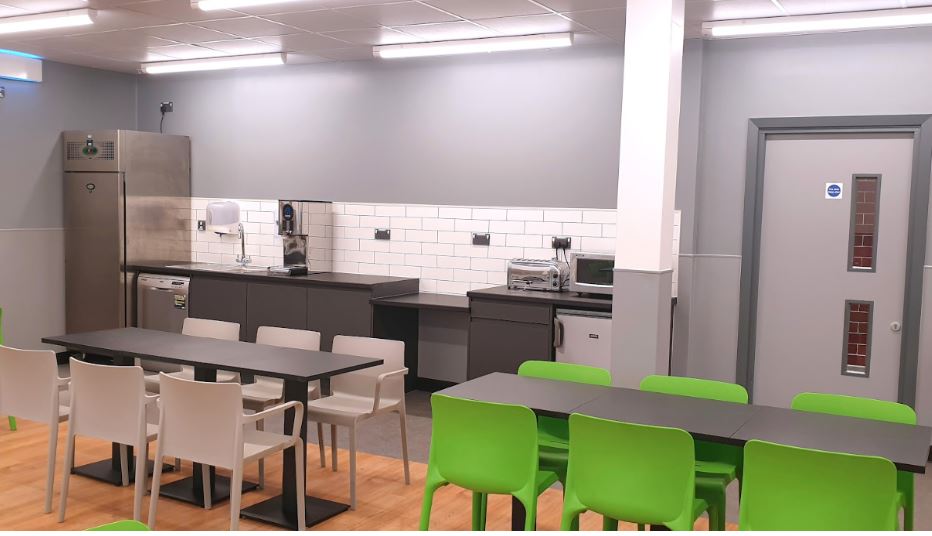PVC vs FRP wall cladding: what’s the best choice for your internal fit-out?
PVC (Polyvinyl Chloride) and FRP (Fiber-Reinforced Plastic) are two popular choices for internal wall cladding in commercial buildings. Both materials offer unique properties and benefits, making them suitable for use in hygiene critical areas across various sectors such as hospitals, schools, office buildings and restaurants.
In this blog, we will compare PVC and FRP wall panels, focusing on their antimicrobial properties, advantages, limitations, maintenance, and durability.
What is FRP, and how does it differ from PVC?
FRP panels are made from a composite material consisting of a polymer matrix, typically a thermoset resin like polyester or epoxy, reinforced with strong fibres, commonly glass fibres. The fibres provide strength and durability to the panel.
In comparison, PVC panels are made from rigid polyvinyl chloride, a synthetic plastic material known for its versatility, durability, and ease of processing. PVC panels are manufactured using an extrusion process. In this process, PVC resin is melted and forced through a shaping die to create a continuous profile of the desired shape and size. The extruded profiles are then cooled and cut into individual panels.
Although FRP has been widely used for interior wall cladding for decades, there has been a significant increase in the use of PVC panels, especially in the fit-out of hygiene critical areas like bathrooms, kitchens, laboratories and operating theatres. This can be attributed to PVC offering the following advantages:
Advantages of PVC wall panels
Antimicrobial Properties
While both PVC and FRP panels can be manufactured with antimicrobial materials such as silver-ions, it’s easier and more effective to do so with PVC. Manufacturers can mix the silver-ions directly into the PVC resin before the extrusion process, ensuring a uniform distribution of the antimicrobial properties within the panel. This means that the panels will continue to provide protection against the spread of microbes even when knocked, dented, stained or scratched for the lifetime of the product as the silver ion additive goes all the way through the body of the product, not just the surface.
FRP panels require a different approach to introduce antimicrobial properties, which typically involves adding antimicrobial coatings or surface treatments after the FRP panels are already manufactured. Surface treatments are less effective and long-lasting than the uniform distribution of antimicrobial properties achieved in PVC panels during the manufacturing stage.
Waterproof and Non-Porous
PVC panels are waterproof and non-porous, which means they do not absorb moisture. This property makes them ideal for areas with high humidity, such as bathrooms, kitchens, and other wet spaces. Unlike FRP, PVC panels do not have backers that can allow moisture to seep into the panels and damage the walls underneath.
Easy to Clean and Maintain
PVC panels have a smooth surface that is easy to clean and maintain. They do not attract impurities or bacteria, and regular cleaning with mild soap and water is usually sufficient to keep them in excellent condition. On the other hand, FRP panels have a rough surface that requires more frequent and costly maintenance to keep them clean.
Recyclability
PVC panels are more cost-effectively recycled compared to FRP panels. PVC can be recycled up to seven times, contributing to sustainability efforts and reducing environmental impact. FRP, on the other hand, is made up of a complex composition of polymers and monomers, making it difficult to separate and recycle.
Thermoformability
PVC panels can be easily thermoformed, meaning they can be bent and moulded to fit around corners and curves seamlessly. This feature eliminates the need for vulnerable seams, which can harbour germs and microbes, making PVC panels more hygienic and suitable for healthcare and food-related applications.
Longevity and Durability
PVC wall panels have a longer lifespan compared to FRP panels. PVC's resistance to moisture, impact, and discoloration ensures that they retain their appearance and structural integrity for many years. Some PVC panels come with guarantees of up to 30 years, while FRP panels typically have shorter warranties, often around 5 years.
Aesthetic Options
PVC panels offer a wide range of colour and finish options, allowing for more design flexibility and customization. On the other hand, FRP panels typically have a chalky white colour that might discolour over time.
Overall, PVC wall panels' antimicrobial properties, waterproof nature, ease of maintenance, recyclability, and design options make them a superior choice over FRP panels for many internal fit-out applications, especially in environments where hygiene and longevity are essential considerations.
Start your infection control journey with AM360
The team at AM360 is ready to help start you on the way to getting the best infection control fit-out materials on the market. All of our PVC wall cladding products utilise silver-ion technology* and have been lab-tested to rapidly kill viruses and prevent the growth of bacteria, mould, and viruses.
Talk to us today and limit your infection risks by calling 1300 884 978 or by filling out the enquiry form below, and we'll get back to you.
*Please note that all our products contain ionic silver, unlike other products on the market which contain colloidal silver/nano silver. According to researchers at Rice University, in order for silver to be effective in killing bacteria, it has to be in its ionised form. Colloidal silver/nano silver is therefore benign in the presence of microbes.



